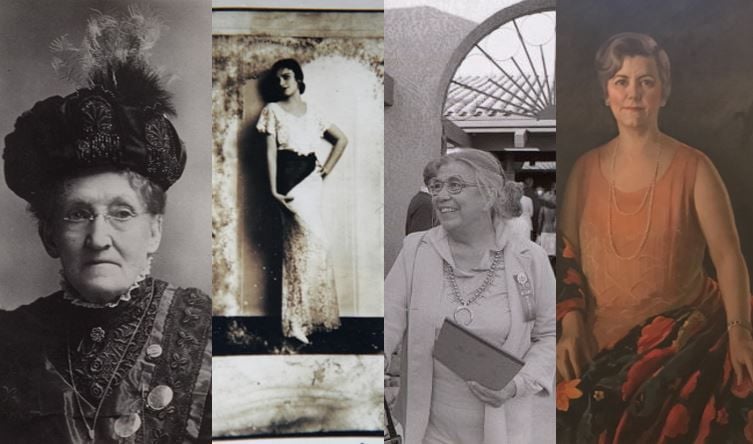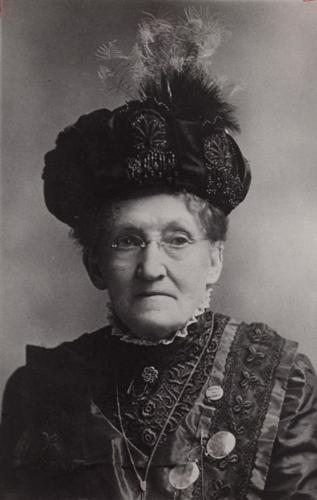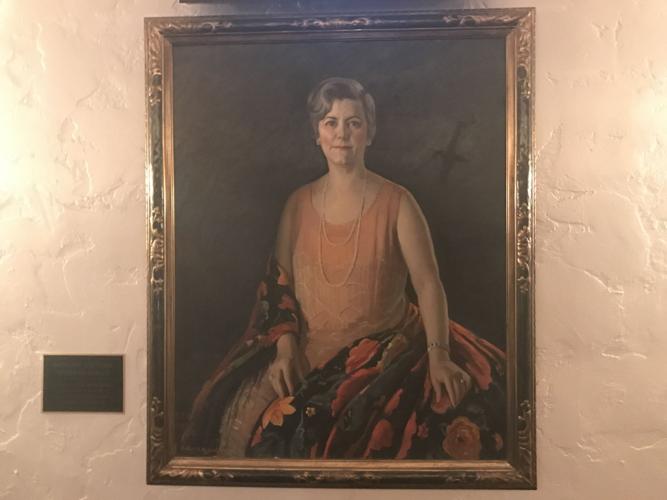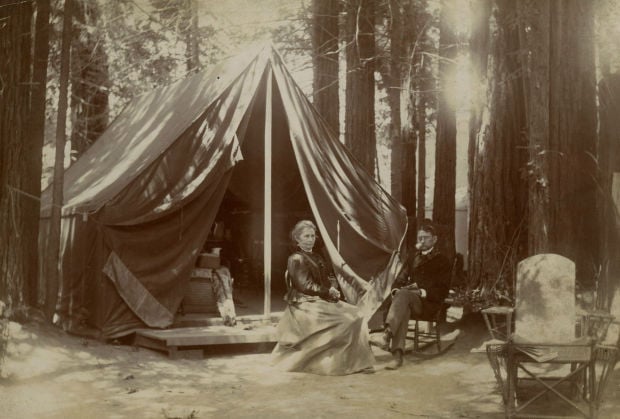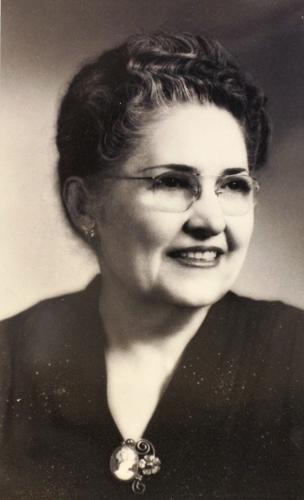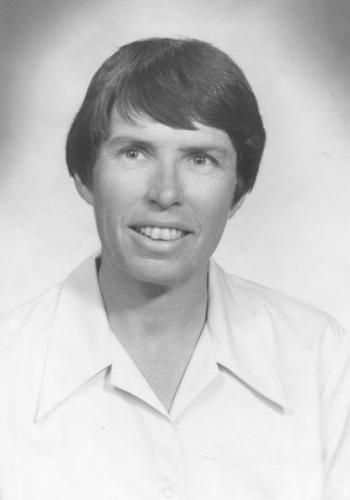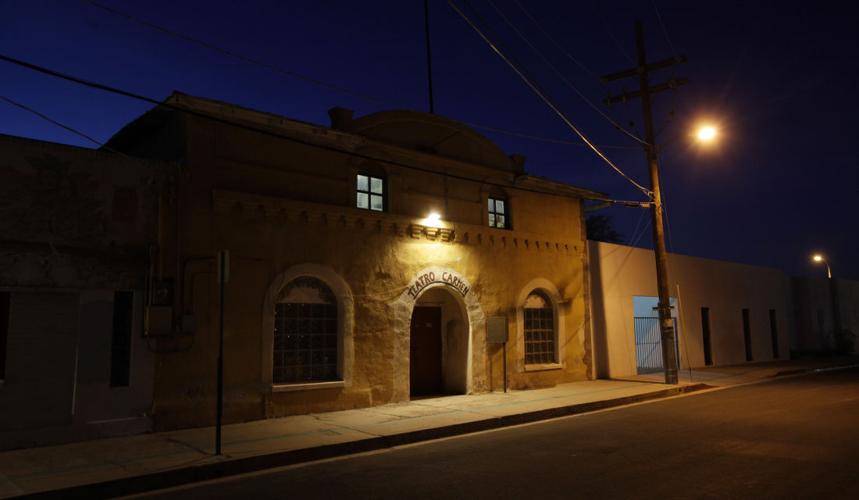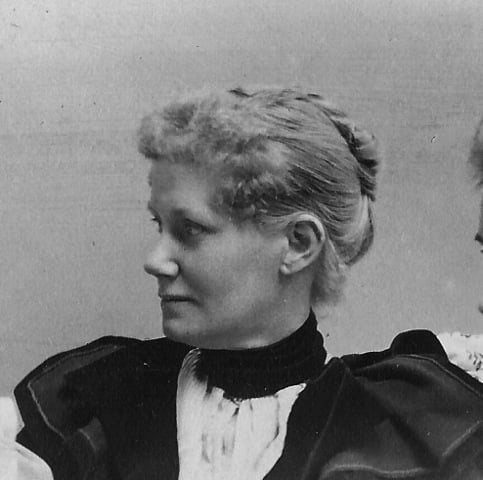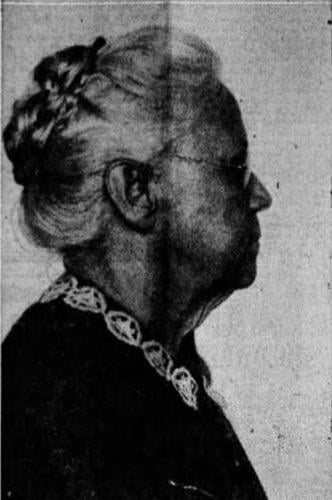March is the month when we celebrate the women who have gone before — those who stood up, spoke out and made history.
March is Women's History Month, and Tucson's past has no shortage of sheroes.
You may not have heard these women's stories in your history class (we're looking at YOU Father Kino.) But we are trying to remedy that with this list of Tucson ladies of lore. It's also doing double duty to get us ready for International Women's Day this Thursday, March 8.
We'll start with:
Josephine Brawley Hughes
1839-1926

Josephine Brawley Hughes in 1887.
Josephine Brawley Hughes traveled to Tucson in the early 1870s with a baby on one hip and a loaded rifle on the other, watching for anyone who might threaten her stage coach.
Hughes was following her husband, an attorney, who had moved out to the dusty Southwest to open a law office. Born in Pennsylvania, the young mom made it to San Francisco by train, San Diego by boat and Tucson by stage coach.
Upon arrival, she infused her frontier-town home with touches from her East Coast life — carpet in the parlor, grass in the front, candles for light and a cistern for water.
We'll admit, we're fans of Hughes' — for a while, she ran the Arizona Daily Star.
Hughes meant business whether people agreed with her or not (and many did not).
During her lifetime in Tucson, she:
• Taught in Tucson's only public school for girls.
• Traveled to Philadelphia for the nation's Centennial as the Commissioner for Arizona to the Women's Department.
• Helped to organize and fundraise for the first Protestant church in Arizona — a Presbyterian congregation — and later backed the first Methodist church in town.
• Used her husband's position as owner of the Arizona Daily Star to advocate for causes dear to her heart. Among them: Higher education, temperance, women's suffrage and the removal of bands of raiders during a time of conflict between Southwestern settlers and Apaches. She did not let saloons advertise in the paper and changed the Star's payday from Saturday to the beginning of the week so employees would not blow their paychecks on alcohol.
• Stayed in Tucson to take over the management of the Star when her husband Louis C. Hughes became territorial governor in 1893.
• Helped found the Arizona Suffrage Association.
• Raised a son who became a senator in the first Arizona state legislature and introduced a state constitutional amendment to let women vote even before Congress passed the 19th Amendment. That bill passed in 1912, letting Arizona women vote years before Congress said so.
• Was inducted into the Arizona Women's Hall of Fame in 1990.
Sources: "Levi's and Lace: Arizona Women Who Made History" by Jan Cleere; the Arizona Women's Hall of Fame; "Western Women: Meet Crusader Elizabeth Josephine Brawley Hughes" by Jan Cleere for the Arizona Daily Star.
Maria Luisa Legarra Urquides
1908-1994

Maria Urquides, center, wouldn’t put up with policies that forbade teaching kids in their native languages.
Maria Luisa Legarra Urquides put herself through what is now Arizona State University by cleaning toilets — and singing a bit at a local restaurant.
Born and raised in Tucson as a third-generation Mexican American, Urquides grew up in a school that forbade her from speaking Spanish.
Upon her graduation from the Arizona State Teachers College at Tempe (ASU) as valedictorian, she returned to Tucson to teach at the segregated Davis Elementary School.
Although her students were mostly Mexican American and Yaqui, the same rules from her childhood applied: Teach only in English.
That fueled her life's passion for bilingual education.
During her lifetime in Tucson, she:
• Taught for 20 years at Davis Elementary School and upon transferring to Sam Hughes Elementary, a mostly Anglo school with better resources, began her quest for bilingual and multicultural education.
• Helped establish Oury Park and a recreation center complete with library, auditorium and swimming pool.
• Worked with other teachers to create the report "The Invisible Minority," based on surveys exploring bilingual education in schools in five southwestern states.
• Served on the White House Conference on Children and Youth multiple times after separate appointments by presidents Harry S. Truman, Dwight D. Eisenhower and Richard M. Nixon. The presidential respect continued when President John F. Kennedy assigned her to the Arizona State Advisory Committee to the Civil Rights Commission and President Lyndon B. Johnson appointed her to a national advisory committee on Mexican-American education.
• Taught Mexican teens at Pueblo High to read and write in their native Spanish and eventually became the high school's dean of girls.
• Developed a reputation as "Mother of Bilingual Education."
• Served and led many organizations that advocated for women, education and cultural studies.
• Was inducted in the Hispanic Hall of Fame and the Arizona Women's Hall of Fame in 2002 and received numerous awards for her work from organizations such as the University of Arizona, the YWCA and the National Association for Bilingual Education.
Sources: "Levi's and Lace: Arizona Women Who Made History" by Jan Cleere; "Western Women: Mother of bilingual education enterprising from young age" by Jan Cleere for the Arizona Daily Star; the Arizona Women's Hall of Fame.
Cele Peterson
1909-2010

A 1940s Arizona Daily Star ad says you can get silk and wool dresses that are "simple enough for the office and smart enough for anywhere" for less than $20 at Cele Peterson's.
Debbie Reynolds did, so did Elizabeth Taylor and the rest of Tucson.
It was her Southwest-inspired apparel called "Station Wagon Togs" that attracted so many people. Everyone knew her and her shop on Pennington Street that survived the Great Depression, World War II, and a fire in 1956 that injured many employees.
She was Tucson's fashion icon for 75 years. And just look at her. Her style is still inspiring.
During her lifetime in Tucson, she:
• Opened the Cele Peterson Shop on Pennington Street, along with other stores around the city.
• Was one of the founders of the Children's Museum.
• Hosted a local radio show called "Star of the Day."
• Provided a building for Sister Kathleen Clark to open Casa de los Niños (We'll tell you about her in a bit).
Sources: "Tucson fashion pioneer Cele Peterson passes at 101" by Bonnie Henry (2010) and "Cele Peterson dies at 101" by Daniel Buckley (2010).
Madeline Heineman Berger
1875-1943
Madeline Berger was the driving force behind the creation of the Temple of Music and Art on Scott Avenue.
She loved the arts so much that she started a club of Tucson women that also loved the arts called the Saturday Morning Musical Club.
The Temple got its start because Madeline's growing club needed a place to meet and perform.
Madeline wanted a sacred space for the arts and a temple is what she got. But it wasn’t easy, she struck a deal with wealthy snow bird and brother-in-law Alexander Berger. He agreed to donate most of the money if she could get donations from other Tucson merchants.
Thousands of people came to the opening of the Temple in 1927. It became quite the attraction in Tucson because of the shows it put on and the people that performed there.
The temple became Madeline's whole life. She even had her funeral at the Temple when she died in 1943.
Now the Temple of Music and Art is the home to the Arizona Theatre Company. Madeline’s portrait hangs in the lobby. A lot has changed over the years but we think she’d be glad to know that the arts are still being honored in that building.
During her lifetime in Tucson, she:
• Founded the Saturday Morning Musical Club, a group of amateur but talented performers and art enthusiasts.
• Became and remained president of the club for more than 30 years.
• Opened and founded the Temple of Music and Art.
• She sponsored the first program of the Tucson Symphony Orchestra.
Sources: "Madeline Berger built her Temple" by Bonnie Henry (1989) and "The Saturday Musical Club celebrates its 50th Birthday" by Barbara Sears (1957).
Sara Allen Plummer Lemmon
1836 or 1840 (accounts vary)-1923

Sara Lemmon, left, and her husband, John Lemmon, are pictured in an unknown place. Mount Lemmon was named for Sara Lemmon, who rode up it on horseback in 1881 with her husband and Emerson O. Stratton.
Okay, so she's not a Tucson resident, but how could we not include her on this list?
If it weren't for her, we would probably call Mount Lemmon by another name.
Born in Maine, Sara Allen Plummer Lemmon went to college in Massachusetts and taught school in New York. She came to Southern Arizona from her home in California in the 1880s on honeymoon with her husband, botanist John Gill Lemmon.
Star archives show that they called it their "botanical wedding trip."
They tried to climb the Santa Catalinas three times from the south with no luck.
The couple headed north toward Oracle where they set off again, an ill John Lemmon on pack mule and his wife following on foot.
They encountered a rancher who set them up with two horses and a guide: Himself.
E.O. Stratton took them up the mountains to the highest peak. The story goes that they christened the mountain "Mount Lemmon" in honor of Sara Lemmon, "the first white woman up there," writes Stratton in the book "Pioneering in Arizona: The Reminiscences of Emerson Oliver Stratton & Edith Stratton Kitt."
During her lifetime, she:
• Started the first library in Santa Barbara, California.
• Worked with her husband to collect, research and publish articles on plant specimens.
• Discovered new species in the Santa Catalinas that also bear the Lemmon name.
• Developed and curated with her husband the Lemmon Herbarium in California.
• Influenced California's adoption of the golden poppy as the state flower.
• Returned to Mount Lemmon with her husband to climb the peak again for their 25th wedding anniversary.
Sources: "Street Smarts: Highway, Mountain named for botanist" in the Arizona Daily Star (2015); "Life stories: Mt. Lemmon's namesake was female explorer" in the Arizona Daily Star (2011); "Mrs. Lemmon's Work Lauded" in the Oakland Tribune (1923).
Sisters of St. Joseph of Carondelet

The seven Sisters of St. Joseph of Carondelet who ventured to Tucson to start a school and heal the sick.
In 1870, seven nuns arrived in Tucson after a long trek from St. Louis, Missouri via train, boat and carriage.
These gutsy women endured the desert's hot days and cold nights, the threat of attack en route from people and animals and even marriage proposals from lovelorn cowboys unaccustomed to women traipsing the wild west.
All of that just to arrive in Tucson, a dusty frontier town that needed the good graces of these seven sisters: Ambrosia Arnichaud, Hyacinth Blanc, Emerentia Bounefoy, Maximus Croisat, Martha Peters and Euphrasia Suchet.
THOSE NAMES! 😍
They came to start a school in a town that had trouble finding funding to keep one afloat.
But these sisters did it, and as their numbers grew, so too did their educational outreach. They raised money for their endeavors by asking anyone and everyone who would give: Miners, cattlemen, regular Tucsonans and wealthy Mexicans.
Through their faithfulness and perseverance, this order of sisters left their mark on Tucson and Arizona.
During their early years in Arizona, they:
• Started schools in Tucson, Yuma and Florence and on the Tohono O'odham and Pima reservations, along with a hospital in Prescott that eventually became a school.
• Opened St. Joseph's Convent and Academy for Females.
• Turned a orphanage-damaging windstorm into a blessing. After starting a novitiate in 1876 and then transforming it into an orphanage for about 30 kids, they used a windstorm that destroyed the building as momentum to fundraise and open a new orphanage large enough for 100 kids.
• Established St. Mary's Hospital in 1880.
• Opened the St. Mary's School of Nursing in 1914.
• Left a legacy of sacrifice, compassion, healing and education for future sisters (You'll meet one of their successors in just a few moments).
Sources: "Levi's and Lace: Arizona Women Who Made History" by Jan Cleere; "Western Women: The Sisters of St. Joseph of Carondelet" by Jan Cleere for the Arizona Daily Star (2014); "A Heritage of Loving Service: The Sisters of St. Joseph of Carondelet" in the University of Arizona's digital history project "Through Our Parents' Eyes: History and Culture of Southern Arizona."
Monica Flin
1887-1975

Tucson's oldest Mexican restaurant was opened and owned by a woman. And it still is.
Monica Flin opened El Charro when it was rare for women to own a business. She opened the restaurant in 1922 as a way take care of herself after two failed marriages.
It is still thriving, 95 years later.
In that time, she did it all by herself. She was the hostess, the waitress and the chef in a small location on South Fourth Avenue and East 17th Street. The restaurant moved several times before it found a permanent residence in the Flin family home, built by her father Jules, in 1968.
"El Charro is not a restaurant so much as it is an extension of Monica Flin's jolly personality," according to an article published by the Tucson Daily Citizen in 1952.
El Charro Cafe still stands on Court Avenue — it's the inviting yellow building. It is owned and operated by Monica's grandniece Carlotta Flores and her family. The restaurant is open seven days a week for lunch, happy hour and dinner. Check out the menus here.
During her lifetime in Tucson, she:
• Opened El Charro, considered one of the best Mexican restaurants in American by the New York Post in 2015.
• Invented the chimichanga or a fried burrito.
Sources: "The Flin era: creating the El Charro family traditions" featured in the Arizona Daily Star (2002) and "Today's Citizen: Supplies One of Life's Pleasures" in the Tucson Daily Citizen (1952).
Sister Kathleen Clark
1919-2003

Sister M. Kathleen Clark at Casa de los Niños.
Sister Kathleen Clark's idea was simple. She wanted to build a haven for abused children.
She decided this after she saw so many of the same abused children during her shifts at St. Joseph's Hospital.
She opened Casa de los Niños in 1973 when she realized she was going to have to be the one to help them. The shelter offered children a free and safe place to go while their parents got the help they needed.
This was the first crisis nursery in Tucson and one of the first in the U.S.
Tucson fashion icon Cele Peterson gave Sister Kathleen her the house for the crisis center, on the corner of Fourth Avenue and Speedway Boulevard. It's actually still being used by Casa de los Niños.
Now, Casa de los Niños welcomes children 12 and under to the crisis center and has grown to assist families in more ways than Sister Kathleen could with a thrift store and multiple locations in town.
During her lifetime in Tucson, she:
• Opened one of the first crisis centers in Tucson and the U.S., Casa de los Niños.
• Published "A Dream Come True", a history of Casa de los Niños.
Sources: "Infant crisis center is nun's special project" by the Arizona Daily Star (1978) and casadelosninos.org.
Sister Clare Dunn
1934-1981

Sister Clare Dunn.
Sister Clare Dunn's four terms as a Democrat serving in Arizona's House of Representatives made her the only nun to serve in the state legislature and the first in the nation to hold a public office.
Dunn, along with her aid Sister Judith Lovchik, advocated for those in need of a voice. She also took up causes important to women.
"She tried to use the system to help those she felt were getting a raw deal, the poor, the minorities, the downtrodden. She worked her tail off for them," Rep. Jim Skelly, R-Scottsdale, told the Star in 1981 following Dunn's death in July of that year.
Both Dunn and Lovchick, Sisters of St. Joseph of Carondelet, were killed in Marana in 1981 on Interstate 10 driving southbound when a car headed in the opposite direction collided head-on with them in their lane.
Both women were 46.
Dunn joined the Sisters of St. Joseph of Carondelet in 1955 and held a master's in history from Mount St. Mary's College (now Mount St. Mary's University) in Los Angeles.
During her lifetime in Tucson, she:
• Taught history and government at Salpointe High School before running for office in 1974.
• During her campaign she championed legislative reform, passing the equal rights Amendment and a number of social issues.
• Represented Tucson's District 13, which at that time was a midtown-northeast Tucson combo.
• During her service as a State House representative from 1975 to 1981, developed a reputation for being genuine and kind, even to her political opponents.
Sources: "For State House, Dist. 13" in the Arizona Daily Star (1976); "Rep. Clare Dunn dies in I-10 crash" in the Arizona Daily Star (1981); "Diverse politicians mourn loss of legislator 'who had no enemies" in the Arizona Daily Star (1981); "Rep. Clare Dunn seeking re-election in Dist. 13" in the Tucson Daily Citizen (1976); Arizona Women's Hall of Fame.
Dr. Clara M. Schell
1872-1955

Dr. Clara M. Schell.
Dr. Clara M. Schell's name comes up again and again in old copies of the Arizona Daily Star.
Schell was not only Arizona Territory's first woman optometrist, but she also made her mark on a number of local organizations, including the county humane society and the Business and Professional Woman's Club.
She used her influence to advocate for women's suffrage and children's needs and other causes near to her heart.
She helped to establish the Arizona Children's Home and Tucson's YWCA.
Schell was awarded one of the first lifetime memberships given by the Arizona State Association of Optometrists. 👓👓
During her lifetime in Tucson, she:
• Studied optometry in Chicago with her husband after their 1892 marriage.
• Moved to Tucson and was granted with her husband, Henry A. Schell, optometry licenses No. 1 an No. 2 by the Territory of Arizona.
• Led the Woman's Business Club as president and traveled to Phoenix to petition the legislature on behalf of the women in the club.
• Retired from optometry in 1946, according to a Star announcement.
Sources: "Clara Schell, 82, dies in Tucson" in the Arizona Daily Star (1955); "Dr. Clara M. Schell reports her work on new wage bill" in the Arizona Daily Star (1923); "Dr. Clara M. Schell elected 1923-24 president of Business Woman's Club" in the Arizona Daily Star (1923); "Dr. Clara Schell to Spend Summer in California," Arizona Daily Star (1948); Arizona Women's Hall of Fame.
Louise Serpa
1925-2012

Louise Serpa made a name for herself photographing rodeos and horse shows.
Louise Serpa keeps company with Annie Oakley, Laura Ingalls Wilder and Georgia O'Keeffe in the National Cowgirl Hall of Fame in Texas.
She's Tucson's rodeo photographer extraordinaire, the first woman given permission to shoot photos inside a professional rodeo ring.
But she never did it to prove anything as a woman. She did it because she needed money, had a job and wanted to do it well.
Serpa often told interviewers she was born in the wrong place at the wrong time — into New York society in 1925.
She could sing, and so she performed in USO shows and graduated from Vassar College. Her first marriage in that world did not last, and life took her West. Divorced, she married again and settled on a sheep ranch in Oregon. That, too, ended.
So she trekked to Tucson, two daughters in tow. And here is where she discovered her lifelong passion: Rodeo.
During her lifetime in Tucson, she:
• Started photographing junior rodeos with drugstore camera and selling her prints to parents for 75 cents.
• Got close to bucking animals to get the shot — in the early days, she couldn't afford a long lens.
• Traveled throughout the Southwest, following the rodeos.
• Survived a goring by a bull that broke her sternum and ribs.
• Shot England's Grand National Steeplechase and the Dublin Horse Show in 1970 and the Sydney Royal Easter Show in 1975, and was mostly likely the first woman allowed to take photos on the grounds of these events.
• Received the National Cowboy and Western Heritage Museum's Tad Lucas Award and an honor from the Pima County Sports Hall of Fame.
• Photographed every Tucson rodeo between 1963 and 2011.
• Continued to shoot rodeos despite a cancer diagnosis.
Sources: "Pioneer rodeo photographer honored" in the Arizona Daily Star (1999); "Eastern doffed her glove to become top rodeo photographer" in the Arizona Daily Star (1996); "Picturing the cowboy life" in the Arizona Daily Star (2005); "Photographer's advice on rodeos, life: 'Never don't pay attention'" by Jan Cleere for the Arizona Daily Star (2015).
Carmen Soto de Vasquez
1861-1934

El Teatro Carmen, a Spanish-language theater in Barrio Viejo, was founded by Carmen Soto de Vasquez and once attracted famed performers.
Carmen Soto de Vasquez made Tucson the place to be for Spanish-language theater.
When her theater El Teatro Carmen debuted May 20, 1915, it attracted performers from Mexico and Spain to Tucson.
The plays, musicals and operas that took up residence in the Sonoran-mission-style theater infused this wild western town with some culture.
If you were headed to a performance at El Teatro Carmen, you dressed to impress.
The adobe theater could seat as many as 1,400 patrons of the arts.
After nine years of running the theater, the family moved to Nogales. The building still stands and went through several incarnations, first hosting movies and boxing matches and eventually becoming a garage. You can still find it at 348 S. Meyer St.
During her lifetime in Tucson, she:
• Supported a Nogales orphanage and adopted at least three children.
• Brought Spanish-language arts to Tucson with the opening of El Teatro Carmen.
• Invited well-known Spanish and Mexican performers to come to Tucson and develop a following outside of their country and among Tucson's Hispanic population.
• Sold the theater in 1926.
Sources: Arizona Women's Hall of Fame; "Western Women: Carmen Soto's theater was cultural center" by Jan Cleere for the Arizona Daily Star (2015).
Isabella Greenway King
1886-1953

From left, Mrs. Mary Harriman Rumsey, New York millionaire, First Lady Eleanor Roosevelt, and Rep. Isabella Greenway of Arizona, at the Junior League Ball at the Mayflower Hotel in Washington, DC in 1934.
Eleanor Roosevelt's bff Isabella Greenway opened the Arizona Inn and became Arizona's first congresswoman.
Isabella moved to Ajo, Arizona in 1922 after the death of her first husband and marriage to her second husband, both war veterans.
She moved her family to Tucson following the death of her second husband. And after his death, she found solace in visiting war veterans in Tucson hospitals where they made crafty wooden items. The Arizona Hut was born when she realized she could get the veterans to make furniture that would sell throughout the country.
The elegant Arizona Inn followed filled with furniture from The Arizona Hut, where most of the visitors were wealthy and famous.
She was even active in Franklin D. Roosevelt's election and became Arizona's first congresswoman, constantly fighting for Arizona.
"It was no easy task for me to make up my mind to toss my sombrero (or shall I say bonnet?) into the coming congressional race," she said about deciding to run.
That's not even the best part. She did it all while raising a child on her own.
During her life in Tucson, she:
• Became Arizona's first congresswoman for two terms.
• Opened The Arizona Hut, a furniture shop meant to help disabled World War I veterans keep their jobs.
• Opened the Arizona Inn with furniture made at The Arizona Hut.
• Was bffs with Eleanor Roosevelt.
• Is honored in Women's Plaza of Honor at the University of Arizona.
Sources: Arizona Women's Hall of Fame; "Western Women: Isabella Greenway was first Arizona congresswoman" by Jan Cleere for the Arizona Daily Star (2016); Arizona Inn's History Book; "Isabella Greenway: An Enterprising Woman" by Kristie Miller.
Sarah Herring Sorin
1861-1914

Sarah Inslee Herring Sorin ran one of the first female law practices in the Arizona territory.
Besides being the first woman lawyer in Arizona, she impressed the country by being the first woman to argue her case by herself (without a man) in front of the U.S. Supreme Court.
Even better, she won the case.
"Mrs. Sorin also disproved that women and logic are strangers, or at least she proved that she and logic are intimate acquaintances," according to an Arizona Daily Star article published in 1913.
Sarah studied law under her father before attending law school in New York City. She practiced law in Tombstone, Tucson, and Globe, where she was highly respected.
During her lifetime, she:
• Became the first woman teacher in Tombstone before starting her law career.
• Became the first woman lawyer in Arizona.
• And the first woman lawyer to argue a case before the U.S. Supreme Court without a man at her side in 1913.
• Is honored in Women's Plaza of Honor at the University of Arizona.
Sources: Arizona Women's Hall of Fame; "Tucson lawyer in U.S. Supreme Court" by the Arizona Daily Star (1913).
Louise Foucar Marshall
1864-1956

Louise Foucar Marshall awaited trial in a county jail cell.
This is the woman who has a whole foundation and UA building named after her. But we bet you don't know her backstory.
Louise Foucar Marshall shot her husband Thomas Marshall multiple times. Later, she was acquitted of the first-degree murder charge when doctors said the man died from an operation-induced infection, not the actual shooting. Age 70 at the time, she pleaded guilty, saying she was temporarily insane.
Marshall was born in Boston and studied in Europe. Later, she earned two degrees from the University of Denver. She moved to Tucson in 1898 to soothe some health issues.
Marshall's story is actually pretty sad when you learn about her life before the shooting. Her once-happy marriage fell apart as rumors swirled about her husband having an affair and an illness she couldn't shake. Doctors' tests revealed poison in her system, and she blamed her husband and his lover.
Following the murder, the trial and the acquittal, Marshall continued her business endeavors and work with the Marshall Charitable Foundation.
Murderer or not, she made her mark here.
During her lifetime in Tucson, she:
• Became the first woman professor at the University of Arizona at the age of 36. She taught botany and a number of languages.
• Aspired to help other young women go to school at the UA.
• Became the head of the Department of Ancient and Modern Languages.
• Purchased and developed land around the UA to use as rental income to support students she wanted to help get through school.
• Developed the first retail stores near campus, a string of properties that later became University Boulevard.
• Created the Marshall Charitable Foundation (now the Marshall Foundation) to fund scholarships for students.
Sources: "A Remarkable Woman" by the Marshall Foundation; "Influential friends in east are seeking to assist Mrs. Marshall" in the Arizona Daily Star (1931); "Mrs. Marshall quickly freed by jury verdict" in the Arizona Daily Star (1931); "Bonnie Henry: Book tells enticing story of wealthy husband-killer" in the Arizona Daily Star (2009).
Polly Rosenbaum
1899-2003

100-year-old Polly Rosenbaum sits at the desk in the old House chambers at the Arizona State Capitol building where her political career began.
Edwynne "Polly" Cutler Rosenbaum lived to be 104 years old.
In that time, she served in the Arizona State Legislature for 46 years, becoming "Arizona's longest serving legislator."
Polly fought for women. In the 60s, she and other female lawmakers made the Arizona State Constitution gender neutral by removing the word "male" as a requirement for becoming an elected state official.
Then she helped establish the Arizona Women's Hall of Fame because women rock. She believed women won the West, not the men.
"The women are the ones who got the libraries and worked for the schools," she said.
Polly was most proud of her legislation that allowed counties to impose a tax for public libraries, according to an Arizona Daily Star editorial.
"She was a gem, and an example of how some legislators are dedicated to service and the public good," it reports.
During her lifetime in Arizona, she:
She actually didn't spend much time in Tucson, but she's still awesome.
• Known by her colleagues as "First Lady of the Arizona Legislature" for serving in the Arizona State Legislature for 46 years.
• Advocated for education, public libraries, recognizing women's contributions and historic preservation.
• Helped establish the Arizona Women's Hall of Fame.
• Has a building named after her in Phoenix called Polly Rosenbaum Archive and History Building at 1901 W. Madison St.
• Has a writing contest named after her.
Sources: Women's Plaza of Honor; Arizona Women's Hall of Fame; Arizona Women's Heritage Trail; and "Polly" in the Arizona Daily Star (2003).
Editor's note: Versions of these stories originally appeared on This Is Tucson in March 2017.


